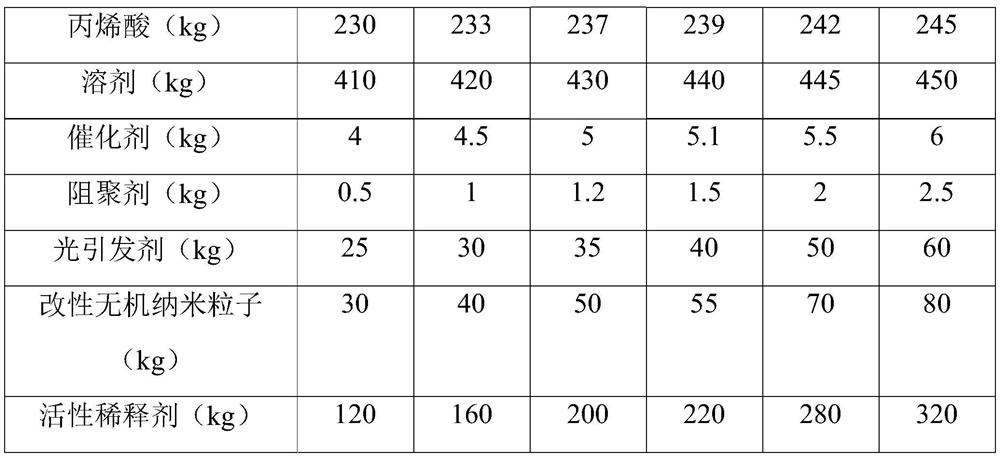A kind of high refractive index photosensitive resin and preparation method thereof
A technology of photosensitive resin and high refractive index, applied in the field of photosensitive resin, can solve the problems of low refractive index and achieve high transparency, low price and good chemical resistance
- Summary
- Abstract
- Description
- Claims
- Application Information
AI Technical Summary
Problems solved by technology
Method used
Image
Examples
Embodiment 1
[0041] The present embodiment provides the preparation method of the above-mentioned high refractive index photosensitive resin, comprising the following steps:
[0042] 1) Under the condition that the temperature is 78°C, the reactive diluent is subjected to reduced pressure and vacuum treatment for 4.2 hours.
[0043] 2) After mixing 3-glycidylpropyltrimethoxysilane and titanium dioxide nanoparticles in a molar ratio of 1:2.5, ultrasonically dispersed for 3 hours to obtain modified inorganic nanoparticles.
[0044] 3) Add the proportion of epoxy bisphenol fluorene and solvent into the reaction kettle, turn on stirring, heat up to 102°C, and stir until the epoxy bisphenol fluorene is completely dissolved.
[0045] 4) The acrylic acid, the catalyst and the polymerization inhibitor of the proportioning amount are mixed to obtain a mixture, and the mixture is added to the reactor in 3 times within 25 minutes, reacted for 7 hours, discharged, and the modified inorganic nanopartic...
Embodiment 2
[0047] The present embodiment provides the preparation method of the above-mentioned high refractive index photosensitive resin, comprising the following steps:
[0048] 1) Under the condition that the temperature is 80°C, the reactive diluent is subjected to reduced pressure and vacuum treatment for 4 hours.
[0049] 2) After mixing 3-(methacryloyloxy)propyltrimethoxysilane and silica nanoparticles in a molar ratio of 1:3, ultrasonically dispersing for 2 hours to obtain modified inorganic nanoparticles.
[0050] 3) Add the epoxy bisphenol fluorene and the solvent in proportion to the reaction kettle, turn on stirring, heat up to 105°C, and stir until the epoxy bisphenol fluorene is completely dissolved.
[0051] 4) The acrylic acid, the catalyst and the polymerization inhibitor of the proportioning amount are mixed to obtain a mixture, and the mixture is added to the reactor in 4 times within 30 minutes, and the reaction is carried out for 6.5 hours. The diluent and the phot...
Embodiment 3
[0053] The present embodiment provides the preparation method of the above-mentioned high refractive index photosensitive resin, comprising the following steps:
[0054] 1) Under the condition that the temperature is 82°C, the reactive diluent is subjected to reduced pressure and vacuum treatment for 3.8 hours.
[0055] 2) After mixing 3-(acryloyloxypropyl)trimethoxysilane and zirconia nanoparticles at a molar ratio of 1:5, ultrasonically dispersing for 1 hour to obtain modified inorganic nanoparticles.
[0056] 3) Add the epoxy bisphenol fluorene and the solvent in proportion to the reaction kettle, turn on and stir, heat up to 108° C., and stir until the epoxy bisphenol fluorene is completely dissolved.
[0057] 4) The acrylic acid, the catalyst and the polymerization inhibitor of the proportioning amount are mixed to obtain a mixture, and the mixture is added into the reactor in 5 times within 35 minutes, reacted for 6 hours, discharged, and the modified inorganic nanoparticl...
PUM
| Property | Measurement | Unit |
|---|---|---|
| refractive index | aaaaa | aaaaa |
| refractive index | aaaaa | aaaaa |
Abstract
Description
Claims
Application Information
 Login to View More
Login to View More - R&D Engineer
- R&D Manager
- IP Professional
- Industry Leading Data Capabilities
- Powerful AI technology
- Patent DNA Extraction
Browse by: Latest US Patents, China's latest patents, Technical Efficacy Thesaurus, Application Domain, Technology Topic, Popular Technical Reports.
© 2024 PatSnap. All rights reserved.Legal|Privacy policy|Modern Slavery Act Transparency Statement|Sitemap|About US| Contact US: help@patsnap.com










